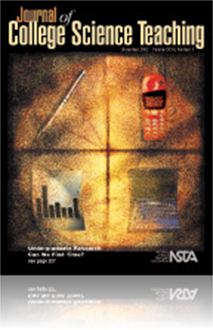All Resources
Journal Article
An opinion piece about the benefits of student teaching and some tips for those just beginning their "diving" careers....
Journal Article
The instructors of an Earth science course used WebCT, a multipurpose software package, to create an online supplement to their course. It included class e-mail, science hyperlinks, an online calendar, an online discussion board, and online handouts....
Journal Article
Inquiry dot Com: Web-based activities promote scientific inquiry learning
Inquiry-based activities found on the Web provide opportunities for students to learn science and may be used to promote inquiry learning. The Web permits students to approach larger, more authentic scientific problems using data-collection and data-...
Journal Article
Test Tube Respiration: The alcoholic fermentation pathway in yeast demonstrates cellular respiration
This article describes an experiment in test tubes that uses the alcoholic fermentation pathway in yeast to illustrate the biochemical process of cellular respiration. The lab effectively integrates two fields of study—biology and chemistry—and h...
Journal Article
Commentary: Learning Techniques for Teachers
An opinion piece about how simple reading strategies are dynamic, timesaving, learning techniques....
Journal Article
Research and Teaching: Inquiry in the Community College Biology Lab
A qualitative analysis of students’ reactions and outcomes to a long-term inquiry experience in a freshman biology course shows positive results. Students posed research questions and designed experiments. The analysis shows that students reacted f...
Journal Article
Editor's Corner: The Answer to Extra Credit
The Science Teacher’s editor shares thoughts on the answer to extra credit assignments....
Journal Article
Service learning provides a novel learning experience for science students while furnishing a service to the community. The implementation and assessment of a service learning project involving an Earth science fair are described. ...
Journal Article
Classroom Composting: Creating compost using an inquiry-based design
This article challenges students through a variety of questions to learn about the optimum conditions necessary for composting. The students had more questions than answers so an internet search was done to gain more information and to expand their u...
Journal Article
Chapterless Science: Taking a new approach to presenting science material
Dividing a scientific discipline into sections or chapters of a book is not always the most effective way of presenting class material to students. This article gets away from the formal and traditional use of textbooks and instead mixes its concepts...
Journal Article
Worms on Ice: Exploring the mysteries of the elusive ice worm
Students and teachers can participate in ongoing scientific research through simple worm experiments in the classroom. During the latest JASON Project expedition, a team of students designed and conducted several experiments comparing ice worms with ...
Journal Article
Favorite Demonstration: The Rules of Research
Demonstrations are wonderful educational strategies for reinforcing and stimulating learning. They are highly instructional as well as entertaining if suitably incorporated into lectures and laboratory sessions. Unfortunately, the educational value o...
Journal Article
The importance of a course that teaches about the biology of women is discussed. This type of course was developed while the authors attended the Women’s Curricular Reform Institute in Oshkosh, Wisconsin. The interaction of biological and sociologi...
Journal Article
Teaching Physics with Dynamic Simulation: Simulators connect science to everyday life
Dynamic simulation has great potential as a tool for teaching physics and general science. These simulators provide students with laboratories for experimenting with phenomena in the context of real situations such as driving, home energy conservatio...
Journal Article
Case Study: <em>Not</em> an Old Person’s Disease
This article describes a case study done in sections. Students first read a scenario and then write down and discuss answers to questions provided by the professor. After discussion, they continue reading, learn a little more about the scenario, and ...
Journal Article
In their team-taught science writing courses, the authors use a series of assignments aimed at specific “real-life” audiences and designed for different venues. Once students understand how to look at the specific needs and expectations of their ...
Journal Article
In the spring 2000 semester, elementary education preservice teachers at Penn State Harrisburg designed and implemented a long-term, interdisciplinary, inquiry-based project. Several students chose to collect baseline data on the ecosystems of the Ly...
Journal Article
Discover if your students are "firewise" and learn how you can help your community survive a wildfire....
Journal Article
Mentoring Students in an Introductory Science Course
To improve success levels of students enrolled in anatomy and physiology (A & P), an introductory science course at Indiana University Northwest, a mentoring program was put in place for two years. The academic success of mentored students was compar...
Journal Article
Science Sampler: Perceptions about Moon phases
One of the most common topics about which students have misconceptions is the phases of the Moon. This article features a two-week course about Moon phases including classroom instruction, videos, field observations, and simulations....






